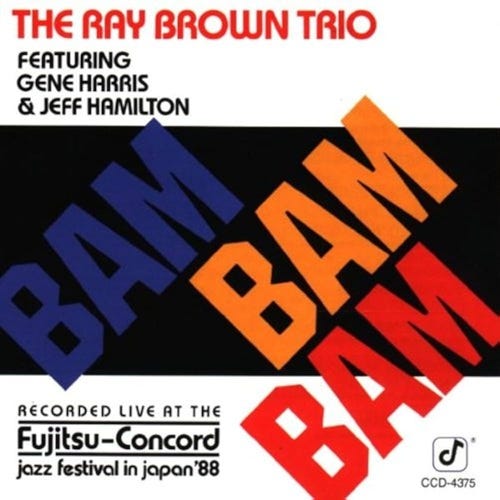The 100 Best Live Recordings - No. 95: The Ray Brown Trio - Bam Bam Bam
No. 95 - The Ray Brown Trio - Bam Bam Bam - Recorded Live at Fujitsu-Concord Jazz Festival in Japan ‘88 (Concord Records, 1989)
This entry is misleading in the respect that bassist Ray Brown is the leader of a trio of titanic equals. The title could have just as easily been The Gene Harris Trio or The Jeff Hamilton Trio. The key operative in this first-among-equals project is pianist Gene Harris (1933—2000). Harris collaborated extensively with Brown, particularly in the later stages of their careers. The pianist was notable for having led the soul jazz trio, The Three Sounds, who released a string of important recordings on the Blue Note label between 1956 and 1970. Mostly retired to his home in Boise in the late 1970s, it was Brown who coaxed him back on tour in the early 1980s. Harris and Brown recorded Bam Bam Bam well into this successful collaboration.
The Ray Brown Trio recorded Bam Bam Bam at the 1988 Fujitsu-Concord Jazz Festival in Tokyo, releasing the recording on Concord Records a year later. A seamless blend of individual virtuosity and collective musicality characterises the recording. Each member claims their fair share of solo space in this recital, with Brown receiving the lion’s share of the acreage with Harris running a close second. Hamilton, though, has the plum spots for showing off.
Brown kicks the show off with alto saxophonist Ornette Coleman’s “F.S.R. (For Sonny Rollins),” a contrafact of Rollins’ “Doxy.” Brown delivers the introduction, sparing with the rhythm section before breaking into that familiar Brown walking bass, swinging in perfect time. Harris adds the ornamentation with his blues-infused, two-fisted note rolls that seem to smile. Hamilton deftly keeps the time with an encouraging rather than propulsive urge. Brown’s solo is elegant and understated before breaking into his walk toward the coda while Harris trades eights with Hamilton. Brown crisply executed his ending, tying the song up in a bow.
Drummer Hamilton’s feature is “Night in Tunisia,” though one might think it is Brown’s. After the formalities, Brown and Hamilton engage in a musical exchange, finally leaving Hamilton to play the Dizzy Gillespie tune solo. His playing is delicate and understated except when it’s not snare and tom-tom bombs dropping left and right. Brown provides a skeletal arrangement, with Harris and Hamilton filling out the rest.
The showstopper is Harris’ feature. The pianist reprises his arrangement of the Gershwin-Heyward “Summertime” from his Three Sounds on Here We Come (Blue Note, 1962). In the intervening 25 years, Harris spruces up the standard, making it a multi-genre juggernaut introduced with Harris’ brand of the smiling blues strides amid thundering arpeggios, dissolving into a two-chord dirge saturated with the blues. Harris teases the melody with a high trill before a light-speed descent into the trisyllabic opening word, drowning in the blues. Gradually, Harris pushes the momentum ever so slightly toward a dense crescendo. From there, Harris picks up the tempo, rolling out block chords as he approaches his big statement, again teasing the composer into a hysteria that resolves into the most perfect barrelhouse rock and roll and rhythm and blues, one could hope to hear at a jazz concert. Then with staccato elegance, Harris goes all gospel for the coda, bringing the old song full circle.
Therefore, this album is on this list.




This album always makes me smile. The trio is so tight and swinging hard. Thanks for bringing it back to my attention.